APPENDICES
APPENDIX A-1
DEFINITIONS FOR UTILIZATION STUDY
Administrative: Administrative numbers are numbers used by telecommunications carriers to perform internal administrative or operational functions necessary to maintain reasonable quality of service standards. Subcategories used in the Utilization Studies are:
· Internal Business Purpose/Official Numbers: A number assigned by a service provider for its own internal business purposes
· Test Numbers: Telephone numbers (TNs) assigned for inter-and intra-network testing purposes
· Other Administrative Numbers (include only Location Routing Number, Temporary Local Directory Number and Wireless E911 ESRD/ESRK) where
· Identical to a Local Routing Number (LRN): The ten-digit (NPA-XXX-XXXX) number assigned to a switch/point of interconnection (POI) used for routing in a permanent local number portability environment
· Temporary Local Directory Number (TLDN): A number dynamically assigned on a per call basis by the serving wireless service provider to a roaming subscriber for the purpose of incoming call setup
· Wireless E-911 ESRD/ESRK: A ten-digit number used for the purpose of routing an E911 call to the appropriate Public Service Answering Point (PSAP) when that call is originating from wireless equipment. The ESRD identifies the cell site and sector of the call origination in a wireless call scenario. The Emergency Services Routing Key (ESRK) uniquely identifies the call in a given cell site/sector and correlates data that is provided to a PSAP by different paths, such as the voice path and the Automatic Location Identification (ALI) data path. Both the ESRD and ESRK define a route to the proper PSAP. The ESRK alone, or the ESRD and/or Mobile Identification Number (MIN), is signaled to the PSAP where it can be used to retrieve from the ALI database, the mobile caller's call-back number, position and the emergency service agencies (e.g., police, fire, medical, etc.) associated with the caller's location. If a NANP telephone number is used as an ESRD or ESRK, this number cannot be assigned to a customer.
For convenience, "other administrative numbers" are reported as a group for purposes of the Utilization Study
Aging Numbers: Aging numbers are disconnected numbers that are not available for assignment to another end user or customer for a specified period of time. Numbers previously assigned to residential customers may be aged for no more than 90 days. Numbers previously assigned to business customers may be aged for no more than 360 days. For purposes of the Utilization Study, carriers are to separately report aging numbers associated with residential service from those associated with business service.
APPENDIX A-1 (continued)
Assigned Numbers: Assigned numbers are numbers working in the Public Switched Telephone Network under an agreement such as a contract or tariff at the request of specific end users or customers for their use, or numbers not yet working but having a customer service order pending. Numbers that are not yet working and have a service order pending for more than five days shall not be classified as assigned numbers. For purposes of the Utilization Studies, numbers for non-working wireless and for interim number portability are to be considered as assigned numbers in Part 1-Section A and separately identified in Part 2. See Interim Number Portability and Non-Working Wireless for definitions.
Available Numbers: Available numbers are numbers that are available for assignment to subscriber access lines, or their equivalents, within a switching entity or point of interconnection and are not classified as assigned, intermediate, administrative, aging, or reserved.
COC Type: Three-digit element defining the use of the Central Office Code (codes such as 0XX used for access tandem and testboard addressing or a "+" symbol that indicates direct routing to the designated switch in the NPA. 2XX-9XX values are considered NXXs.) Allowable codes in the LERG Destination Code by LATA and Tandem Homing Arrangements (LERG 6/9) are:
ATC = Access Tandem Code (0/1XX)
CDA = Customer Directory Assistance only (555 line numbers are assigned by
the North American Numbering Plan Administration)
EOC = End Office Code
PLN = Planned Code - non-routable
PMC = Public Mobile Carrier (Type 2 Interconnected)
RCC = Radio Common Carrier (Dedicated Type 1 Interconnected)
SIC = Special 800 Service Code
SP1 = Service Provider - Miscellaneous Service (Type 1 Interconnected)
SP2 = Service Provider - Miscellaneous Service (Type 2 Interconnected)
TST = Standard Plant Test Code
Allowable codes in the LERG Oddball file (LERG6ODD only) are:
700 = 700 IntraLATA Presubscription
AIN = Advanced Intelligent Network
BLG = Billing Only
BRD = Broadband
CTV = Cable Television
ENP = Emergency Preparedness
FGB = Feature Group B Access
HVL = High Volume
INP = Information Provider
LTC = Local Test Code
N11 = N11 Code
ONA = Open Network Architecture
PRO = Protected
RSV = Reserved
RTG = Routing Only
UFA = Unavailable for Assignment
APPENDIX A-1 (continued)
Interim Number Portability (INP): The interim ability to move telephone service from one service provider to another service provider using Remote Call Forwarding (RCF), Direct Inward Dialing (DID), or equivalent means where:
· Remote Call Forwarding allows a customer to have a local telephone number in a distant location. Every time someone calls that number, that call is forwarded to the RCF customer in the distant location. Remote call forwarding is similar to call forwarding on a residential line, except that the RCF customer has no phone, no office and no physical presence in that location.
· A DID (Direct Inward Dial) trunk is a trunk from the Central office which passes the last two to four digits of the Listed Directory Number into the PBX thus, allowing the PBX to switch the call thus ringing the correct extension" without the use of an attendant (Newton's Telecom Dictionary). Existing DID retail service is limited to PBX services. For purposes of providing INP, Pacific and GTEC will use the DID switch functionality to provide INP to any CLC customer regardless of the type of terminal equipment used on the customers' premises.
· For the purposes of the Utilization Study, each carrier must report the quantity of its assigned numbers that are dedicated to providing INP under Assigned Numbers in Part 1-Section A and separately identified in Part 2.
Intermediate Numbers: Intermediate numbers are numbers that are made available for use by another telecommunications carrier or non-carrier entity for the purpose of providing telecommunications service to an end user or customer. Numbers ported for the purpose of transferring an established customer's service to another service provider shall not be classified as intermediate numbers. For Type 1 donor carriers, Type 1 numbers are to be reported as intermediate numbers in Part 1-Section A and detailed information is to be provided in Part 2 for the Utilization Studies. For Type 1 recipient donors, Type 1 numbers shall be reported in the Part 1-Section B for the Utilization Studies. For definition, see Type 1 numbers.
Local Number Portability: The ability to move a telephone number from one service provider to another service provider using LRN-LNP technology
APPENDIX A-1 (continued)
Non-Working Wireless: This category is for wireless companies only to report numbers that they have already assigned to customer equipment, but are not yet working. For example, cellular carriers often pre-package a cellular telephone with an assigned telephone number for sale to customers. Those phone numbers are assigned, but are not actually activated until after the customer purchase is made. For the purposes of the Utilization Study, each carrier must report the quantity of its non-working wireless numbers under Assigned Numbers in Part 1-Section A and separately identified in Part 2.
OCN: Operating Company Number (OCN) assignments must uniquely identify the applicant. Relative to CO Code assignments, NECA-assigned Company Codes may be used as OCN's. Companies with no prior CO Code or Company Code assignments should contact NECA (973-884-8355) to be assigned a Company Code(s). Since multiple OCNs and/or Company codes may be associated with a given company, companies with prior assignments should direct questions regarding appropriate OCN usage to the Traffic Routing Administration (TRA) on 732-699-6700
Reserved Numbers: Reserved numbers are numbers that are held by service providers at the request of specific end users or customers for their future use. Numbers held for specific end users or customers for more than 45 days shall not be classified as reserved numbers.
Special Use NXX Codes: Certain NXX codes have traditionally been reserved or designated for special uses, and have not been available for assignment by carriers for general commercial use in providing telephone numbers to customers. These NXX prefixes are restricted to such special uses as recorded public information announcements of time-of-day and weather forecasts, high-volume call-in numbers, and emergency access numbers used by the Federal Emergency Management Administration (FEMA), etc.
Type 1 Numbers: Numbers pursuant to a Type 1 interconnection agreement. The Type 1 interconnection is a connection between a mobile/wireless service provider and an end office of another service provider for the purpose of originating and terminating traffic or for access to end user services (i.e. DA, Operator services, 911, etc). The interconnection consists of a facility between the mobile/wireless service provider and the end office, switch usage, and telephone numbers (only required if the mobile carrier wishes to receive originating (L/M) traffic). For the purposes of the 310 Utilization Study, both mobile/wireless service providers who have received Type 1 numbers and those service providers who have provided Type 1 numbers to mobile/wireless service providers are asked to report on those numbers at the 1000 block level.
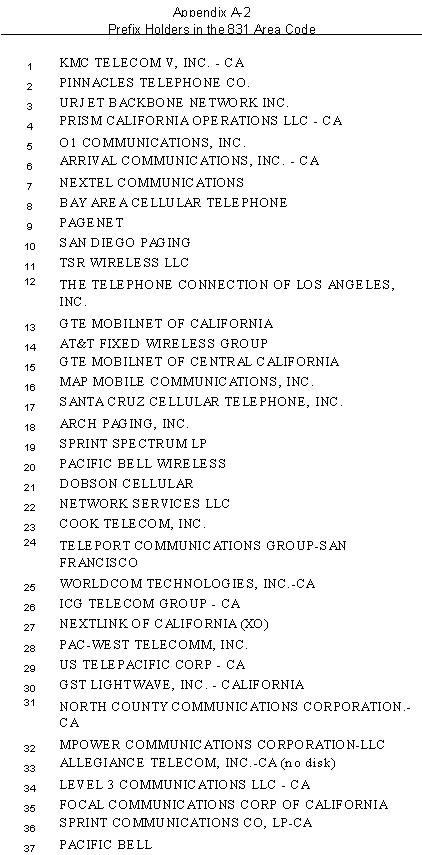
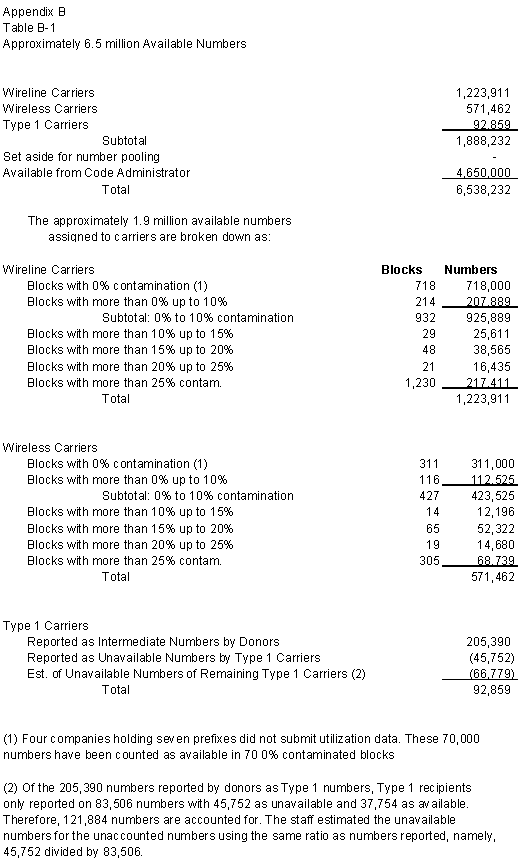

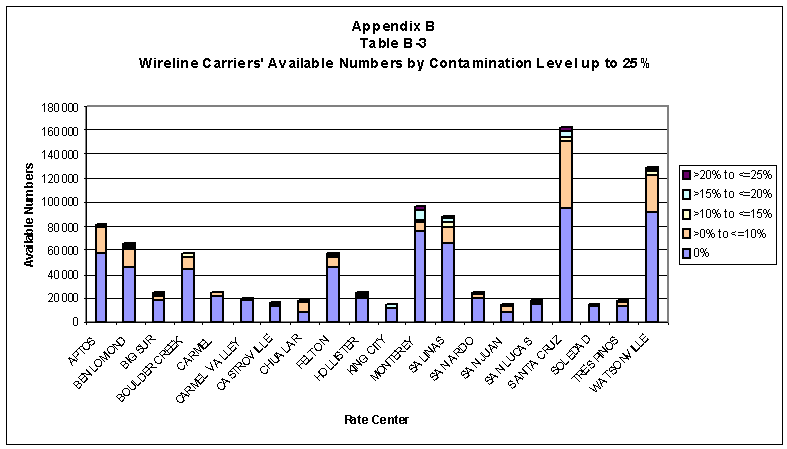
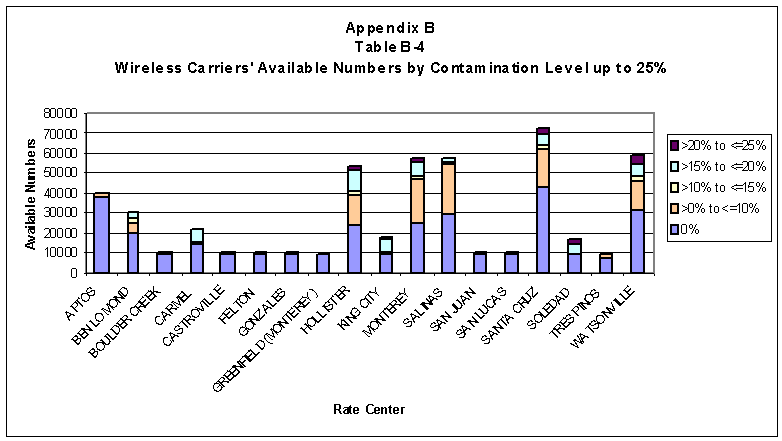

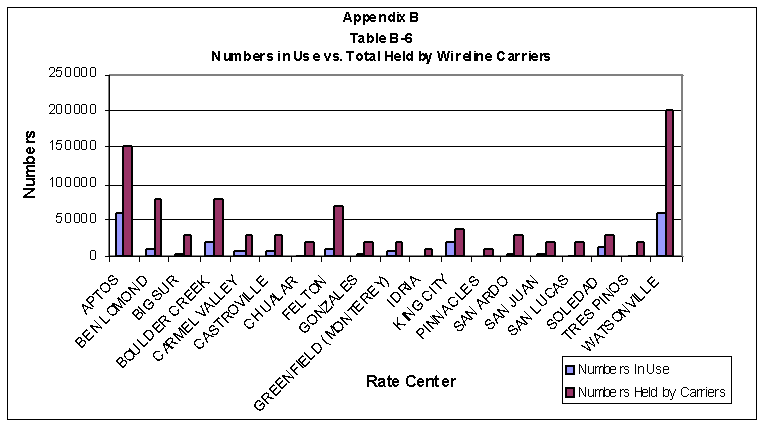
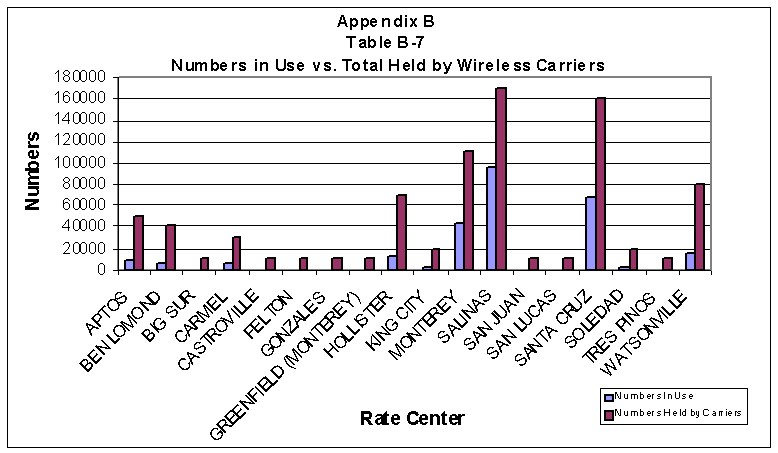

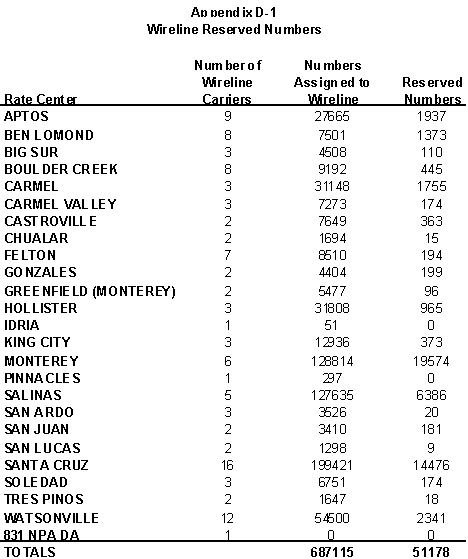
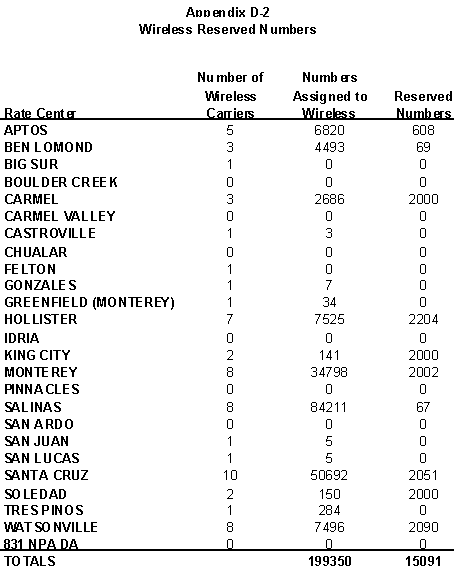

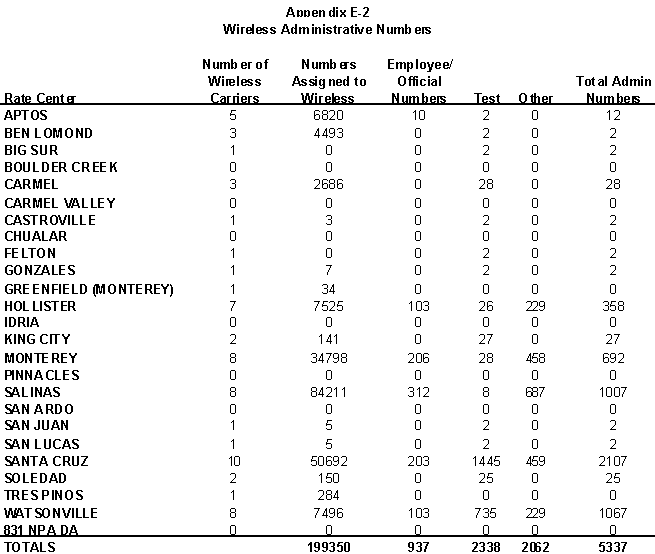
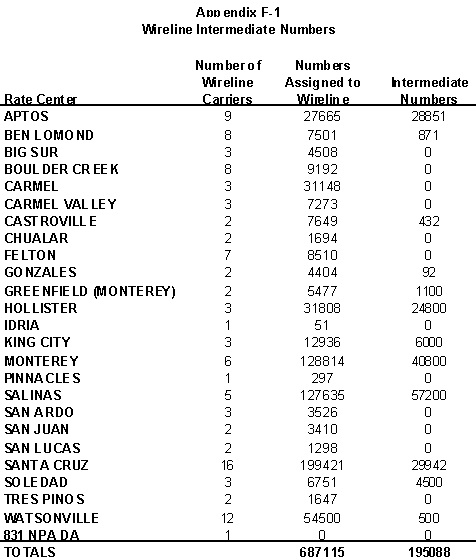

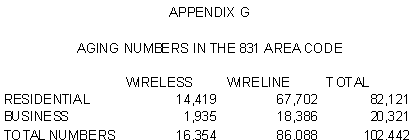
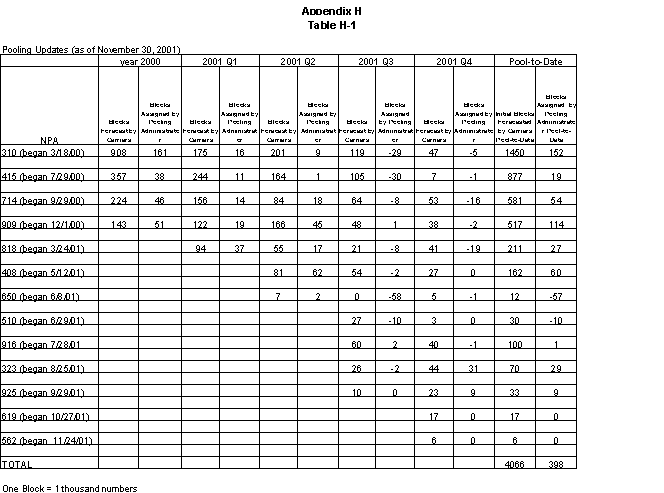
APPENDIX I
SUMMARY OF RECOMMENDATIONS
Recommendation from Block Contamination Analysis of Wireline Carriers
· The CPUC should petition the FCC to increase the contamination level for pooling to 25%. If the FCC grants the petition, the CPUC should increase the maximum contamination level of donated blocks from 10% to 25% for all LNP-capable carriers.
Recommendations from Block Contamination Analysis of Wireless Carriers
· When cellular and PCS companies become LNP capable in November 2002, the CPUC should direct those wireless carriers to donate to and participate in all number pools in California, using the same contamination threshold for donated blocks in effect for all LNP-capable companies.
· The CPUC should solicit comments on the feasibility of paging companies becoming LNP capable and participating in pooling, as well as other methods of reducing the number of stranded numbers held by paging companies.
Recommendations for Block Contamination Issues Affecting All Carriers
· The CPUC should monitor compliance with its fill rate and sequential numbering policies through future number utilization filings and audits.
· The CPUC should establish penalties for non-compliance with fill rate and sequential numbering policies adopted in Decision 00-07-052.67
Recommendations for Treatment of Non-Working Wireless
· Non-working wireless numbers should be treated as reserved numbers and limited to 180 days, after which they should become available for assignment to customers.
· The CPUC should continue to monitor non-working wireless numbers in the near term by reviewing future utilization filings, and should include this category of numbers in any audits conducted of wireless carrier number use.
Recommendations for INP-Related Conservation Measures
· The CPUC should require companies to transition from INP to LNP in the 831 area code and implement a monitoring mechanism to ensure compliance.
· The CPUC should adopt a schedule for transitioning INP arrangements to LNP in all other California area codes.
Recommendations for Special-Use Prefixes
· TD recommends that the CPUC initiate an investigation into the possibility of moving the numbers for time and emergency preparedness into the 555 prefix.
· TD recommends that the CPUC include in its investigation the broader use of the 555 prefix in California's area codes by providing standard 555 numbers in every California area code to provide time, emergency preparedness, and weather information.
Recommendation for Reserved Numbers
· The CPUC should monitor reserved number use for all companies by reviewing future utilization data to ensure companies are complying with the FCC's 180-day requirement.
Recommendations for Administrative Numbers
· The CPUC should develop criteria by which companies assign administrative numbers. The CPUC should consider placing a limit on the quantity or percentage of administrative numbers companies are allowed to hold.
· The CPUC should develop rules that require companies to limit administrative number assignments within certain blocks in a given prefix. In cases in which companies hold multiple prefixes in a single rate center, the CPUC should develop rules that require companies to limit administrative number assignments within prefixes.
Recommendation for Intermediate Numbers
· The CPUC should monitor intermediate number use for all companies by reviewing future utilization filings to test whether potential abuses in this reporting category occur.
Recommendations for Type 1 numbers:
· Wireline and wireless carriers should improve Type 1 number inventory management. Wireline carriers should perform a one-time inventory check of wireless Type 1 numbers to verify their records match that of the wireless Type 1 carriers' records. Companies should make inventory data available to the CPUC upon request. Wireline carriers should recover and add to their inventories any Type 1 numbers lying dormant.
· Type 1 carriers should be subject to number conservation techniques such as sequential numbering and fill rates. A system to ensure compliance with Type 1 number conservation measures should be developed.
· The Commission should consider Type 1 numbers as potential donations to the number pool. Excess and unused Type 1 numbers should be returned to the wireline carriers and either used to serve customers or donated to the number pool.
Recommendation for Aging Numbers
· Although the CPUC has required all companies to differentiate aging numbers between residential and business, and track the two categories separately, Pacific Bell has not complied with these requirements. Pacific Bell should be redirected to differentiate aging numbers between business and residential, track them separately, and report on each category accurately. The CPUC should assess penalties for failure to comply.
Recommendation for Audit
· The CPUC should audit the data submitted by companies in this study and future area code number utilization studies.
Recommendations for Number Pooling
· The CPUC should work with industry groups and the Pooling Administrator to develop specific rules for companies pertaining to forecasting a six-month inventory when a number pool is authorized in a particular area code.
Recommendation for Number Pooling
● The CPUC should audit the data submitted by companies in this study and future area code number utilization studies.
Recommendations for LNP
· The CPUC should continue to work with the FCC to enforce LNP capability mandates for all wireline carriers in the top 100 MSAs.
Recommendations for UNP
· The CPUC should petition the FCC for authority to implement UNP statewide.
· The CPUC should solicit comments in order to develop rules and practices necessary to implement UNP.
Recommendations for Rate Center Consolidation
· The CPUC should undertake further investigation by ordering the telecommunications industry to develop a plan, within 180 days, for rate center consolidation.
Recommendations for Sharing of Prefixes
· The CPUC should further explore sharing of prefixes as a means to more efficiently utilize numbers in all area codes
